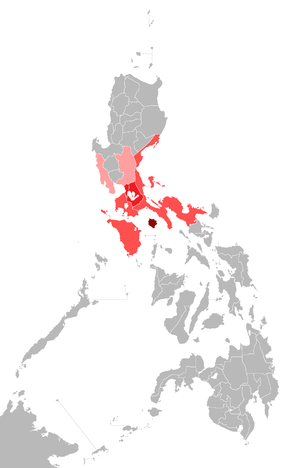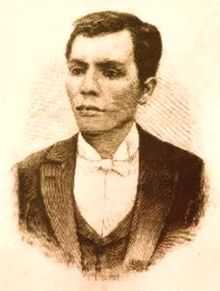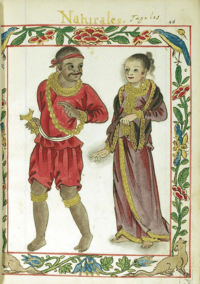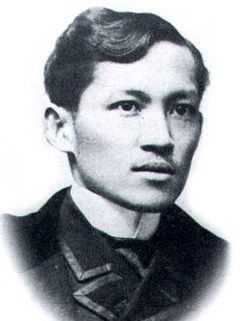Tagalog people
| ||||||||||
| Total population | ||||||||||
|---|---|---|---|---|---|---|---|---|---|---|
| 25 million | ||||||||||
| Regions with significant populations | ||||||||||
|
| ||||||||||
| Languages | ||||||||||
| Tagalog, Filipino, Chabacano de Cavite/Ternate, Spanish language and English | ||||||||||
| Religion | ||||||||||
| Christianity (predominantly Roman Catholic, with a Protestant minority), Islam, and Buddhism) | ||||||||||
| Related ethnic groups | ||||||||||
| Kapampangan, Other Filipinos | ||||||||||
The Tagalog people are a major ethnic group in the Philippines. They form a majority in Metro Manila and the provinces of Aurora, Bataan, Batangas, Cavite, Bulacan, Laguna, Marinduque, Nueva Ecija, Occidental Mindoro, Oriental Mindoro, Quezon, Rizal and Zambales. Other provinces with some significant Tagalog populations include the provinces of Palawan, Nueva Vizcaya, Camarines Norte and Camarines Sur.
Etymology
The name Tagalog comes from either the native term tagá-ilog, meaning 'people living along the river', or another native term, tagá-alog, meaning 'people living along the ford' (the prefix taga- meaning "coming from" or "native of").[1] During the latter part of the 20th century, the people of this ethnolinguistic group rarely refer to themselves as "Tagalog," and instead, identify themselves simply as "Filipino." This was a misnomer that could have developed from their language being used as the basis for the Philippine national tongue and a manifestation of the dominance they exert throughout the archipelago. Recent developments have shown though that there is a reversal in this trend and a resurgence of Tagalog ethnic identity, one that is distinct from the national identity, is currently underway.
In 1821, Edmund Roberts called the Tagalog, Tagalor in his memoirs about his trips to the Philippines.[2]
Demographics
Tagalog people number about 28.1% of the total Filipino population making them the second largest major indigenous Filipino ethnic group, second to Visayans.[3][4][5][6] Tagalogs speak the Tagalog language, with many dialectal variations, although all Tagalog dialects are considered to be mutually comprehensible to each other. The principal religion of Tagalogs is Christianity, mainly Roman Catholicism with a minority practicing Islam, concentrated in the Quiapo district of Manila, who themselves may also have Bajau, Maranao or Tausug admixtures, among others. Due to centuries of intense interaction with Europeans and their Asian neighbours, many Tagalogs are of mixed heritage with Chinese and Spanish admixtures the most prevalent.

Tagalogs have ancestries in other ethnic groups such as East Asian and Southeast Asian people that migrated/settled to Manila and the CALABARZON area that assimilated to Tagalog or came even long before the Spanish Conquest. That could have established several native Tagalog communities formed by the assimilation of various indigenous Philippine kingdoms.[7]
Through the years, the Tagalogs have spread out of their traditional geographical areas in southern and central Luzon and migrated into the Visayas and Mindanao. Hence, the Tagalog race has become both a regional cultural group as well as a nationwide culturally-mixed group.[8]
Culture

The Tagalog culture of the pre-Hispanic times was significantly different from its current expression. Traditionally, it was essentially a river and water-based culture, where fishing and agriculture were predominant means of livelihood. Most of the ancient Tagalog cultural centres were founded on riverbanks, specifically near the delta and the "wawa" or the mouth of the river. Riverine communities, especially those by the delta and river-mouth became centers of trade and commerce. In pre-Hispanic Philippines, some of these trade centers were Maynila, Tondo, Sapa, Pasig through the Pasig River; Talim, Bay, Pila, Lumbang through the Laguna de Bai; Balayan though Pansipit River; Lipa and Taal through Bonbon or Taal Lake.[9]
Tagalogs are notable for having very strict adherence to polite conduct and respect, and this is exemplified by both mannerisms and linguistic structure. Tagalogs are also depicted by examples of bravery and courage, as manifested by historical events, e.g., the Philippine Revolution and World War II.
Contemporary Tagalog culture is highly Westernised due to their habitation and geographical proximity to Manila which was chosen as the Philippine colony's capital by the Spaniards and Americans. Despite this, a considerable amount of pre-Hispanic customs and traditions, largely resembling those of the Chinese, Malays and Japanese, survives.
History
-

Tagalog royalty at the time of initial contact with the Spanish. mid-1500s. Boxer Codex
-

Tagalog nobility at the time of initial contact with the Spanish. mid-1500s. Boxer Codex
-

Tagalog nobility at the time of initial contact with the Spanish. mid-1500s. Boxer Codex
The Tagalogs were the first settlers of Manila. However, Taal, Batangas, is considered to be the birthplace and "Heartland of Tagalog Culture." Despite the existence of a writing system and high levels of literacy prior to the arrival of the Spaniards, the Tagalog people passed on most of their culture orally. This was the case as they wrote their ideas on perishable leaves and branches.

Pre-Hispanic information on the Tagalog people is rather limited. The Laguna Copperplate Inscription is the earliest written document to date that mentions the existence of several Tagalog states in the present-day provinces of Laguna, Bulacan and the city of Manila. It also adduces the cultural links classical Tagalog people had with other contemporary Asian civilisations such as the Javanese Medang Kingdom, Srivijaya Empire and the Middle Kingdoms of India. The language used was old Malay with a glut of non-Malay words speculated to be either of Old Tagalog or Old Javanese origins.
Europeans already had contact with the Tagalogs ten years before Magellan encountered Lapu-Lapu on Mactan. The Portuguese referred to them as Luções which was taken after Lusong, the island the Tagalogs inhabited. Lusong was derived from either the Tagalog words meaning pestle and mortar due to the shape of the region around Manila Bay or to wade in water. The Portuguese discovered a community of prominent Tagalog entrepreneurs when they conquered the Sultanate of Malacca (Melaka) on the Malay peninsula in 1511. A Tagalog named Regimo was even appointed temenggung or police commissioner by the Portuguese governor.
Another colony of Tagalogs was also found in Minjam on the Malay peninsula which was selling cotton from Mindoro to the Chinese as early as the 1300s. Surya Diraja, a Tagalog merchant, owned a plantation and estate that exported 175 tons of pepper to China every year. His ship was included in the flotilla that made an official visit to the Chinese empire.
Tagalog presence was ubiquitous in Southeast Asia during pre-colonial times. The port of Canton in China did business with these people as reported by a 1515 Portuguese account and Antonio Pigefetta, Magellan's navigator, spotted a Luzonese ship in Timor in 1521 during their stay in the area. A 1540 Portuguese report noted that the Tagalogs dominated Bornean navigation and were adventurous discoverers.
The Tagalogs also served as mercenaries for the exiled Sultan of Malacca in 1525 during his attempt to regain his city from the Portuguese. An early Portuguese historian, João de Barros, described them as bellicose and valiant. They fought in Aceh in northern Sumatra in 1529 as well and served the king of Burma (Myanmar) in a campaign at Martaban.[10]
In the late 16th century, Spain chose Manila as the capital of its Philippine colony. From then onwards, it has been the political and economic center of the Philippines. Manila and the surrounding Tagalog areas played a leading role in the Philippine Revolution and the People Power Revolution. Throughout the centuries, there have been massive migrations by other ethnic groups to Manila, and many of them have intermarried with the Tagalog people.
A number of Philippine national heroes are of Tagalog heritage. The Tagalogs staged numerous revolts against Spanish colonization, and were also among the earliest. One such revolt was that of Apolinario de la Cruz (Hermano Pule), which was religious in orientation.
The Philippines National hero José Rizal, was born in the Tagalog region of Calamba, Laguna. Rajah Sulayman, a Muslim king who fought the Spanish occupation was a native of Manila.
In 1898, many leaders of the Philippine Revolution were Tagalogs, including, Apolinario Mabini, Andrés Bonifacio, Emilio Jacinto, among others.
Many Tagalogs have assumed the presidency as well: Emilio Aguinaldo, José P. Laurel, Ramon Magsaysay and Joseph Ejercito Estrada. Early Philippine history has always been actively participated by the struggles and triumphs of the Tagalog people and the Tagalogs have come to take an active part in the present Philippine economy and politics.
See also
References
- CCP Encyclopedia or Philippine Art, Peoples of the Philippines, Tagalog
- ↑ "Tagalog, tagailog, Tagal, Katagalugan". English, Leo James. Tagalog-English Dictionary. 1990.
- ↑ Roberts, Edmund (1837). Embassy to the Eastern Courts of Cochin-China, Siam, and Muscat. New York: Harper & Brothers. p. 59.
- ↑ http://www.buzzle.com/articles/list-of-different-ethnic-groups-in-the-philippines.html "Indigenous Ethnic Groups: These include Visayan: The Visayan people are mainly found in the Visayas region and also in some parts of Mindanao. The Visayans speak a large number of dialects that they collectively call the Bisaya language. There more than 33 million speakers of these languages and most of them are Christians. Tagalog: The Tagalog is the most widely spread ethnic group in the Philippines that inhabit Manila, Mindoro, and Marinduque. There are about 22 million speakers of the Tagalog Language that was chosen as the official language of the nation in 1930". Date retrieved 29 DEC 2010.
- ↑ Philippines' People
- ↑ http://www.filipinoplanet.com/filipino-ethnic-groups.html "Visayan: As of 2010 there are 98 million people in the Philippines. Visayans are the largest Filipino ethnic group making up the majority - about 33 million people. Visayans originally come from the Visayas, the middle section of the Philippines. The language of Visayans is Bisaya, however, there are many languages considered Visayan including Aklanon, Cebuano, Ilonggo and Waray-Waray. Tagalog: There are approximately 25 million Tagalog people in the Philippines. Tagalogs originally settled in Manila which then became the capital of the Philippines. Tagalogs speak Tagalog which was the basis for Wikang Filipino or the Filipino Language. The majority of Tagalogs are Christian. Many Filipino National heroes were of Tagalog descent including Jose Rizal, Emilio Jacinto and Andres Bonifacio." Date retrieved 29 DEC 2010.
- ↑ https://www.cia.gov/library/publications/the-world-factbook/geos/rp.html Date retrieved 29 DEC 2010.
- ↑ Tagalog
- ↑ "Lowland Cultural Group of the Tagalogs". National Commission for Culture and the Arts. pp. page on the 4th paragraph.
- ↑ "Lowland Cultural Group of the Tagalogs". National Commission for Culture and the Arts. pp. page on the 9th and 10th paragraph.
- ↑ "Ancient Pinoy entrepreneurs". pilipino-express. 1837. pp. page on the 4th, 5th and 6th paragraph.
| ||||||||||||||||||||||||||||||||||||||||||||||||||||||||||||||||||
.png)






